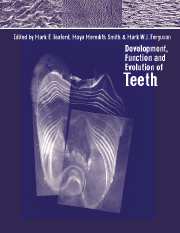Book contents
- Frontmatter
- Contents
- List of contributors
- Acknowledgements
- Part one Genes, molecules and tooth initiation
- Part two Tooth tissues: development and evolution
- Part three Evolution of tooth shape and dentition
- 10 Evolutionary origins of teeth and jaws: developmental models and phylogenetic patterns
- 11 Development and evolution of dentition patterns and their genetic basis
- 12 Evolution of tooth attachment in lower vertebrates to tetrapods
- 13 Tooth replacement patterns in non-mammalian vertebrates
- 14 The evolution of tooth shape and tooth function in primates
- 15 ‘Schultz's Rule’ and the evolution of tooth emergence and replacement patterns in primates and ungulates
- Part four Macrostructure and function
- Index
15 - ‘Schultz's Rule’ and the evolution of tooth emergence and replacement patterns in primates and ungulates
Published online by Cambridge University Press: 11 September 2009
- Frontmatter
- Contents
- List of contributors
- Acknowledgements
- Part one Genes, molecules and tooth initiation
- Part two Tooth tissues: development and evolution
- Part three Evolution of tooth shape and dentition
- 10 Evolutionary origins of teeth and jaws: developmental models and phylogenetic patterns
- 11 Development and evolution of dentition patterns and their genetic basis
- 12 Evolution of tooth attachment in lower vertebrates to tetrapods
- 13 Tooth replacement patterns in non-mammalian vertebrates
- 14 The evolution of tooth shape and tooth function in primates
- 15 ‘Schultz's Rule’ and the evolution of tooth emergence and replacement patterns in primates and ungulates
- Part four Macrostructure and function
- Index
Summary
Introduction
Paleontologists often reconstruct the sequence of eruption of teeth of fossil mammals (e.g., Stehlin, 1912; Gregory, 1920; Kellogg, 1936; Lamberton, 1938; Tattersall and Schwartz, 1974; Wallace, 1977; Kay and Simons, 1983; Gingerich, 1984; Lucas and Schoch, 1990; Smith, 1994; Martin, 1997). Evolutionary studies, however, have contradictory traditions about the meaning of such sequences. One tradition is that sequence of tooth eruption is a good phylogenetic character, capable of showing genetic relatedness among species (e.g., Tattersall and Schwartz, 1974; Schwartz, 1974; Byrd, 1981), and thus presumably non-adaptive or conservatively adaptive. A second school of thought is that sequence of eruption is an adaptive characteristic: either reflecting dental morphology (e.g., Slaughter et al., 1974), or facial architecture (Simpson et al., 1990), or life history (Schultz, 1935, 1956). Indeed Schultz saw the eruption sequence of teeth as highly adapted to rate of post-natal growth. The obvious question is, does sequence of tooth eruption inform us of species taxonomic affiliation, dental function, facial form, or life history? One approach to the question is to re-examine Schultz's hypothesis on the adaptive nature of tooth eruption sequence. Here, Schultz's ideas are tested against newly gathered data on primates and ungulates, with a few additional data on small insectivorous mammals.
The dentition in a life-history context
Reptiles tend to grow throughout life, changing prey, and prey size slowly over time (Dodson, 1975). To keep pace with growth and changing diet, reptiles erupt multiple waves of simple, ever-larger teeth (see Chapter 13). Mammals, however, share a system of tooth emergence and replacement that accommodates rapid growth to a fixed body size (see Pond, 1977; MacDonald, 1984).
- Type
- Chapter
- Information
- Development, Function and Evolution of Teeth , pp. 212 - 228Publisher: Cambridge University PressPrint publication year: 2000
- 63
- Cited by



